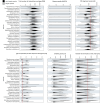RAPiD: a rapid and accurate plant pathogen identification pipeline for on-site nanopore sequencing
- PMID: 39346055
- PMCID: PMC11438431
- DOI: 10.7717/peerj.17893
RAPiD: a rapid and accurate plant pathogen identification pipeline for on-site nanopore sequencing
Abstract
Nanopore sequencing technology has enabled the rapid, on-site taxonomic identification of samples from anything and anywhere. However, sequencing errors, inadequate databases, as well as the need for bioinformatic expertise and powerful computing resources, have hampered the widespread use of the technology for pathogen identification in the agricultural sector. Here we present RAPiD, a lightweight and accurate real-time taxonomic profiling pipeline. Compared to other metagenomic profilers, RAPiD had a higher classification precision achieved through the use of a curated, non-redundant database of common agricultural pathogens and extensive quality filtering of alignments. On a fungal, bacterial and mixed mock community RAPiD was the only pipeline to detect all members of the communities. We also present a protocol for in-field sample processing enabling pathogen identification from plant sample to sequence within 3 h using low-cost equipment. With sequencing costs continuing to decrease and more high-quality reference genomes becoming available, nanopore sequencing provides a viable method for rapid and accurate pathogen identification in the field. A web implementation of the RAPiD pipeline for real-time analysis is available at https://agrifuture.senckenberg.de.
Keywords: Metagenomics; Nanopore sequencing; On-site sequencing; Plant pathogens; Realtime genomics.
© 2024 Knobloch et al.
Conflict of interest statement
The authors declare that they have no competing interests.
Figures



Similar articles
-
Advancing metagenome-assembled genome-based pathogen identification: unraveling the power of long-read assembly algorithms in Oxford Nanopore sequencing.Microbiol Spectr. 2024 Jun 4;12(6):e0011724. doi: 10.1128/spectrum.00117-24. Epub 2024 Apr 30. Microbiol Spectr. 2024. PMID: 38687063 Free PMC article.
-
Relative Performance of MinION (Oxford Nanopore Technologies) versus Sequel (Pacific Biosciences) Third-Generation Sequencing Instruments in Identification of Agricultural and Forest Fungal Pathogens.Appl Environ Microbiol. 2019 Oct 16;85(21):e01368-19. doi: 10.1128/AEM.01368-19. Print 2019 Nov 1. Appl Environ Microbiol. 2019. PMID: 31444199 Free PMC article.
-
Freshwater monitoring by nanopore sequencing.Elife. 2021 Jan 19;10:e61504. doi: 10.7554/eLife.61504. Elife. 2021. PMID: 33461660 Free PMC article.
-
Nanopore Sequencing and Its Clinical Applications.Methods Mol Biol. 2020;2204:13-32. doi: 10.1007/978-1-0716-0904-0_2. Methods Mol Biol. 2020. PMID: 32710311 Review.
-
High-throughput identification and diagnostics of pathogens and pests: Overview and practical recommendations.Mol Ecol Resour. 2019 Jan;19(1):47-76. doi: 10.1111/1755-0998.12959. Epub 2018 Dec 4. Mol Ecol Resour. 2019. PMID: 30358140 Free PMC article. Review.
References
-
- Bag S, Saha B, Mehta O, Anbumani D, Kumar N, Dayal M, Pant A, Kumar P, Saxena S, Allin KH, Hansen T, Arumugam M, Vestergaard H, Pedersen O, Pereira V, Abraham P, Tripathi R, Wadhwa N, Bhatnagar S, Prakash VG, Radha V, Angana RM, Mohan V, Takeda K, Kurakawa T, Nair GB, Das B. An improved method for high quality metagenomics DNA extraction from human and environmental samples. Scientific Reports. 2016;6:26775. doi: 10.1038/srep26775. - DOI - PMC - PubMed
-
- Boykin LM, Sseruwagi P, Alicai T, Ateka E, Mohammed IU, Stanton JAL, Kayuki C, Mark D, Fute T, Erasto J, Bachwenkizi H, Muga B, Mumo N, Mwangi J, Abidrabo P, Okao-Okuja G, Omuut G, Akol J, Apio HB, Osingada F, Kehoe MA, Eccles D, Savill A, Lamb S, Kinene T, Rawle CB, Muralidhar A, Mayall K, Tairo F, Ndunguru J. Tree lab: portable genomics for early detection of plant viruses and pests in sub-saharan Africa. Genes. 2019;10(9):632. doi: 10.3390/genes10090632. - DOI - PMC - PubMed
MeSH terms
LinkOut - more resources
Full Text Sources

